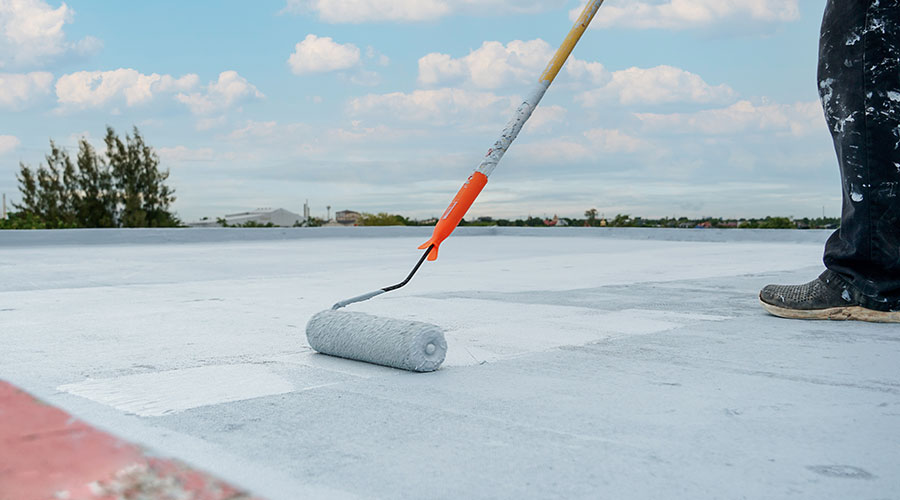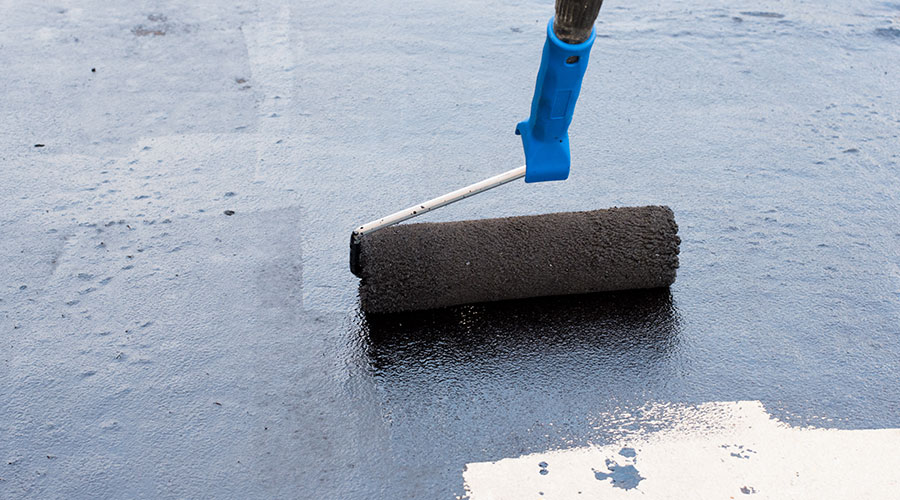Proper Maintenance and Specs Lead to Roofing Sustainability and Longevity
OTHER PARTS OF THIS ARTICLEPt. 1: This Page
REPORT PREPARED FOR RCI INC.
What makes a roof sustainable? That might seem to be a simple question, but the reality is that a range of factors has to be considered to determine whether a roof can truly be considered sustainable. Is the roof made from recycled content and can it be recycled? Does it have a low embodied energy? Can it help a building save energy after is has been installed? Does it help the building reduce stormwater runoff?
It’s a lot to consider. And while all those characteristics are important, arguably the most important factor in sustainability is simply how long the roof lasts.
According to the American Institute of Architects, the average life expectancy of a building is 75 years. An average roof, however, only lasts 15 years, according to the National Roofing Contractors Association. If facility executives are diligent about roof design, system selection and maintenance, and can get 25 years out of a roof instead of the average 15, that would mean two fewer roofs over the life of a building. Hence, the true measure of sustainability is achieved: avoiding raw material use and meeting the needs of the current generation without compromising the ability of future generations to meet their needs.
“In my opinion, making the roof last is the biggest thing a facility executive can do to be sustainable,” says Doug Stieve, principal with Wiss Janney Elstner Associates, and director, Region 1, RCI, Inc.
Roof Insulation, Drains and Longevity
Whether working on new construction or a roof replacement project, facility executives should consider several strategies to make sure they get the longest life possible from a roof.
“A long-lasting roof is a team effort,” says John Willers, president of Rooftop Systems Engineers and immediate past president of RCI, Inc. “The owner provides the funding and the requirements, the manufacturer provides the material, the contractor provides the installation and the consultant provides the design. If any one of those are lacking, it’s going to compromise the whole system.”
A long-lasting roof starts with the design, not just of the roof itself, but in the case of new construction, of the whole building. For instance, try to avoid locating window walls immediately adjacent to roof sections, says Bob Elsdon, president of Elsdon Consulting and first vice president of RCI, Inc. “If you have mirrored glass reflecting the sun onto the roof all day, that raises the roof temperature and increases deterioration.”
Elsdon also says high parapet walls in cold climates may pose problems, especially if there are protrusions or vents near the edge of the roof. If snow drifts and covers these protrusions, it may adversely affect the function of the vents, intakes or exhausts and may also cause premature deterioration of the roof system.
Well-designed drains are of critical importance, as well. “Make sure there is good slope to the roof drains,” says Stieve. “The quicker water gets off the roof or seams, the better. Provide that slope in the deck, not in the insulation.”
Insulation itself is a huge consideration, say experts. In the 1970s, says Stieve, roof membranes were built right over concrete decks, and they lasted nearly forever. “But once we started insulating, the life-expectancy dropped dramatically.”
Energy codes like ASHRAE 90.1 are becoming increasingly stringent in their insulation requirements, and while that’s a plus for energy savings, it’s not necessarily good for the life of the roof. As the roof heats up during the day and cools down at night, it expands and contracts. The more violent this expansion and contraction, the greater the chance for failure.
“The more insulation that is directly below the roof, the greater the thermal stresses on the membrane,” says Richard Cook, vice president at ADC Engineers and second vice president of RCI, Inc. “The heat doesn’t dissipate through the roof assembly, so the heat stays in the membrane. There needs to be effort put into finding a balance between insulation and energy savings and roof life.”
One remedy is to use a cover board or overlay board between insulation and membrane. This can draw some heat from the membrane and lessen membrane degradation. It also provides a better, more solid substrate to fasten into. If a roof is fastened directly into a thick insulation layer, and is expanding and contracting rapidly, the fasteners may come loose.
System Selection
Facility executives have probably heard this advice more than once: Be sure to select building systems that match the function of the facility. The roof is certainly no exception. Oftentimes, though, the only two considerations are first cost and warranty — which is a big mistake, say experts.
“A 20-year warranty on a product doesn’t necessarily mean a 20-year roof,” says David Hawn, president of Dedicated Roof and Hydro-Solutions and president of RCI, Inc. “Many roofs are put in service conditions they’re not meant for. Selection of the right system for the building and location is critical.”
This can mean seeking the advice of a third-party roofing consultant to answer questions in regards to each candidate system: Will there be lots of traffic on the roof? What types weather will the roof be subjected to? How will the roof be maintained and cleaned? How important (if at all) is aesthetics? How long has the particular product been in service? What is the reputation of the manufacturer?
Once a system decision has been made, do everything possible to stay the course. “’Value-engineering’ is the biggest misnomer in the world,” says Hawn. “Rarely does it add value to the roof. Often cost shaved off the roof design is used to upgrade interior finishes. ”
Quality installation is another key to making a roof live a long and full life, so hiring an experienced contractor is incredibly important. Also, make sure that the contractor’s crew is experienced with the particular type of roofing system being installed. That crew should be on site for the whole job. Third-party observation of roof installation quality is also important to roof longevity. “Experienced supervision is critical,” says Willers.
Approximately 90 percent of leaks occur at penetrations and terminations, says Cook, so taking care and time to inspect the details and workmanship in these areas is critical. “RFO, or ‘roofer figure out,’ is not a good specification” says Elsdon.
All these roof system-selection issues are just as applicable to a re-roofing project as they are to selecting a roof on a new building. The first step on a re-roofing project, however, is to learn from any past mistakes.
“Ask yourself, ‘Why are we re-roofing? Was the other roof just old? Or did it fail prematurely, and if so, why?’” says Willers.
Part of making sure the next roof won’t fail prematurely is inspecting the deck and insulation as well. “If there is moisture in the insulation, it must be removed,” says Willers. The reason it should be removed is that wet insulation is just as effective as no insulation at all, from an R-value standpoint. Also, decks — especially metal ones — that are in contact with trapped moisture are sure to fail prematurely.
“The roof surface must be steeply sloped or waterproof,” says Hawn. “Often slope or lack thereof starts with the structural deck. For roof replacement, get down to the structure and assure that it’s in the best possible condition. Assure water can still drain off a roof system; otherwise every time it rains the roof will be subjected to standing water. ”
At the same time, re-roofing is a good opportunity to review the auxiliary components of the roof. Evaluate whether components such as flashings, curbing, pavers, and ballast are still in good working order or whether they need to be replaced.
The Last Step
Even if every precaution is taken, the highest-quality, best-designed system will not reach its old age without proper maintenance. As Hawn puts it, “Maintenance is not what you do to fix a leak. It’s what you do to prevent a leak.”
Inspections should be done at least twice per year. After major weather events, check for ponding, examine integrity of flashings, and check near penetrations for peeling or cracking. Repairs should be done immediately. Other types of preventive maintenance, like clearing drains of debris, may need to be done more frequently.
“The one positive note in the current economy is that owners are now demanding maintenance versus replacement because of their available budgets,” says Cook.
One strategy that can influence the frequency and quality of maintenance is making sure the building allows for easy roof access. Whether this means keeping roof access in mind during initial design or just having the proper equipment on hand to get to the roof, the easier the roof is to reach, the more likely maintenance will be performed.
And the more likely it is that maintenance is performed, the longer a roof will last — which should be the goal of any facility executive interested in sustainability. After all, sustainability and long life are essentially the same idea. As Hawn says, “Continued use is best. To sustain is to continue.” 
About RCI, Inc.
For the first 23 years of its existence (since 1983), RCI, Inc. was known as the Roof Consultants Institute. Its members — consultants, architects and engineers — provided facility executives with independent design, planning, inspection and management services for the roof. But as the years went on, RCI members found themselves called upon to address other concerns. As a result, the organization expanded its mission in 2006 to cover waterproofing and exterior walls and changed its name to RCI, Inc.
RCI, Inc.’s mission is to ensure the credibility of its membership through professional development, ethical behavior and research. RCI, Inc. suggests using an independent roof consultant, sometimes referred to as a roof commissioning agent, to look out for a building’s best interests from the initial conceptual design phase through the final inspection. Throughout the life of a building, the organization’s members are also well-positioned to provide expertise and advice on roof maintenance and repair.
To ensure that facility executives are dealing with experienced professionals, RCI, Inc. offers three registration programs: Registered Roofing Consultant (RRC), Registered Waterproofing Consultant (RWC) and Registered Roofing Observer (RRO). These credentials demonstrate that the person has passed a rigorous examination process and has verified levels of education and continuing education credits.
|
Related Topics:












